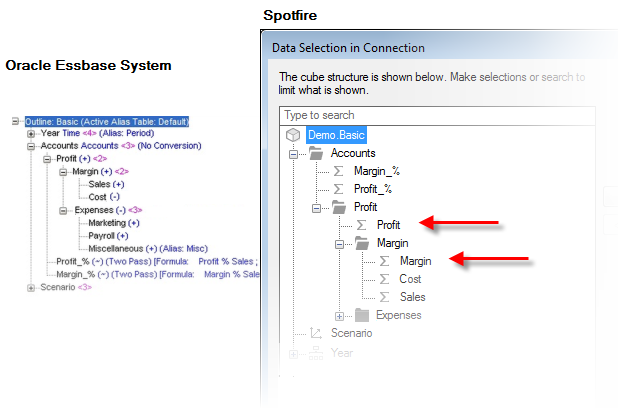
If you have access to data in an Oracle Essbase system, you can use the Oracle Essbase connector in Spotfire to connect to your OLAP cube.
When you configure a connection to an Oracle Essbase cube, you can choose whether to analyze data in-database or to import it into your analysis. Note that you need to install a driver on your computer to get access to the Oracle Essbase connector. See the system requirements at http://support.spotfire.com/sr_spotfire_dataconnectors.asp to find the correct driver.
Note: Measures must be located in the dimension that is the tagged account dimension to be recognized as a measure in Spotfire.
Hierarchical Measures
In Oracle Essbase, measures can be organized in hierarchies, in contrast to other cube data sources.
When the data source structure is shown in Spotfire, measures that are also a parent are shown both as a folder and as a separate measure, which is slightly different compared to what the structure looks like in the Oracle Essbase Administration Services user interface.
Example of Structure

In the Data Selection in Connection dialog in Spotfire, only metadata is shown. This means that even if the Show both member and alias check box has been selected in the Oracle Essbase connection dialog, the member names will still be shown in the Data Selection in Connection dialog. The aliases will be shown in the data when the selection has been added to Spotfire.
Oracle Essbase Data In-database
Each time you make a selection in a hierarchy filter or a check box filter, a request is sent to the Oracle Essbase database to provide the selected data. This means that if you select/clear several check boxes in a filter in Spotfire, many requests may be sent to the database instead of just the request for the final selection. You should try to avoid sending many requests since too many requests at the same time may overload the database and make it go down.
As discussed on Cubes in Spotfire, Spotfire uses a delay of about one second in order to see if there are any additional selections made in a filter before sending the request to the database, but you should also try to restrain the number of changes you do to the data selection in general, when working in-db.
If you filter to only see a few selections, the recommendation is to first right-click on the filter and select “Deselect All Values”, and then select the specific check-boxes you want.
Oracle Essbase Data In-memory
When it comes to import of data from a cube, the most important thing to think about is to limit the data to import as much as possible by making sensible selections. See Importing Data from Cubes for details.
See also: